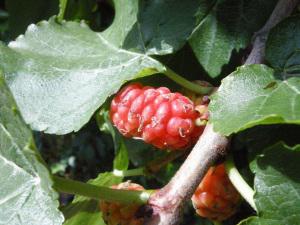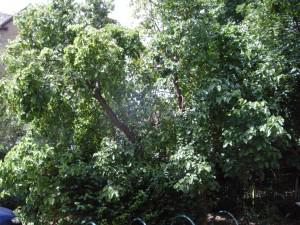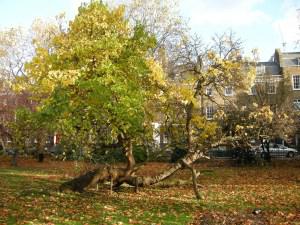
Morus nigra immature fruit (10/07/2011, London)
Position: Full sun
Soil: Moist, well drained soil
Flowering period: Summer
Eventual Height: 8m
Eventual Spread: 10m
Hardiness: USDA Zone 5a-11a
Family: Moraceae
Morus nigra is a deciduous tree with a round headed bush-like habit. Its foliage is composed of leaves that are rounded, deep green, glossy and occasionally lobed, these will turn yellow in autumn. In late summer to early autumn it will bear edible, oval, succulent, dark purple to red fruit that are produced after unusual white flowers that are furry in appearance.

Morus nigra (10/07/2011, London)
M. nigra, commonly known as the Black Mulberry or the Persian Mulberry, is native to south-western Asia, but has been naturalised in many temperate regions around the world including much of Europe. Its fruit is widely used for many purposes, although it does not travel well and commercially is most widely used to produce juice drinks. It is very popular to use the freshly picked fruit to make jams and tarts. This tree was imported into Britain in the 17th century in the hope it would act as food for the silk worm. Unfortunately the silk worm only feeds on the White Mulberry, M. alba.
Morus is the ancient Latin name for the Mulberry tree, with nigra also being Latin, meaning ‘black’.

Morus nigra autumn (07/11/2009, London)
This plant may be useful to the landscape architect as a low maintenance, fast growing and drought tolerant fruit tree. Care should be taken when locating this tree as the falling fruit will stain paving.
The Royal Horticultural Society gave it their prestigious Award of Garden Merit in 1993.
This plant will tolerate almost any soil conditions; it will be happy at neutral, acid or alkaline pH levels, in loam, clay or sand based soils facing any sheltered or exposed aspect. It is also drought tolerant once established.
Ecologically this plant will attract various species of birds that will feed on its fruits. It will not cater to pollinating insects as it is wiind pollinated but will attract the larvae of various species of lepidoptera that will feed on its foliage.
Maintenance: This plant requires little to no maintenance. Dead or damaged material may be removed in late winter or early spring.

